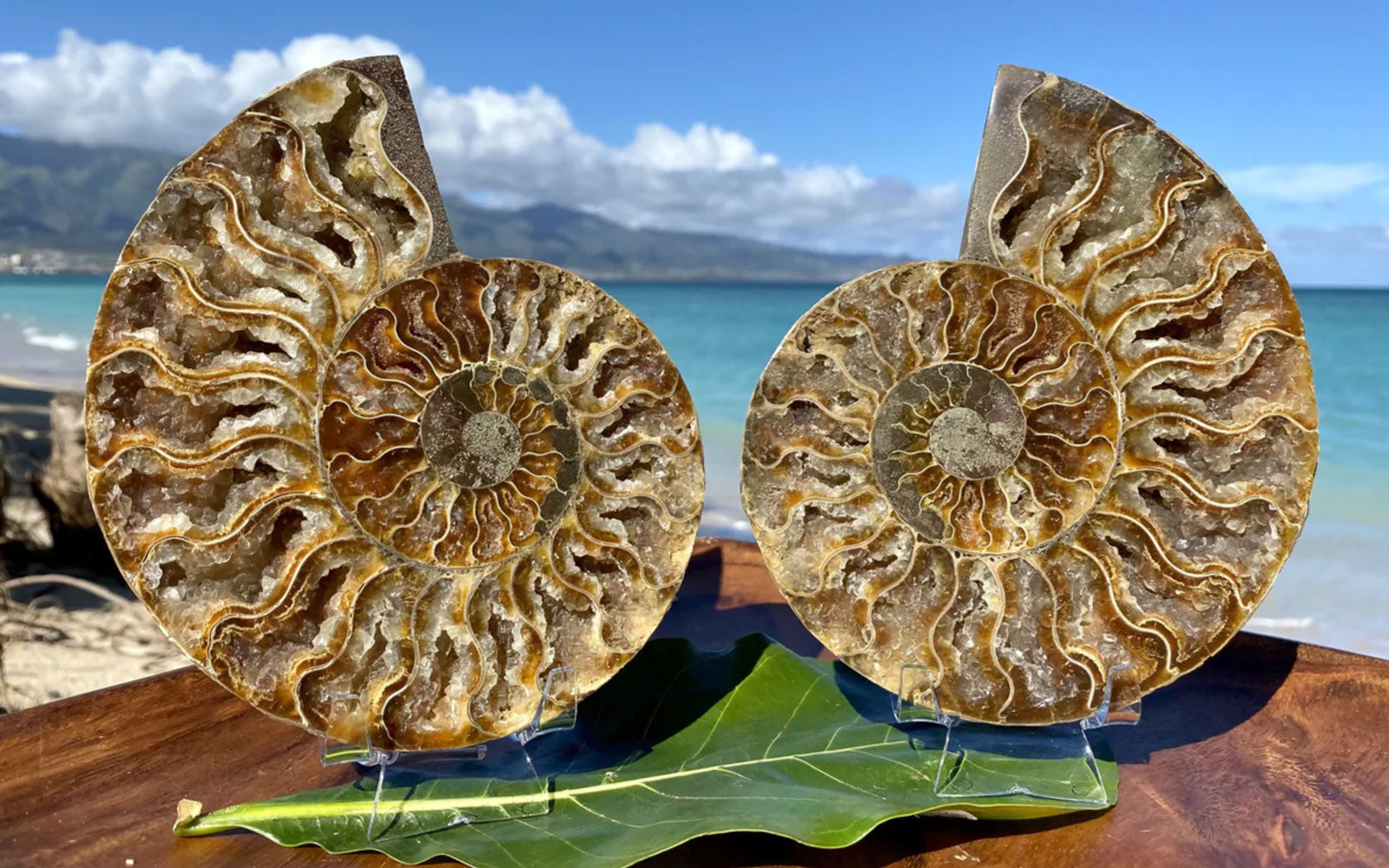
Trilobites and Ammonites: All You Need to Know
Fossils have long held a special fascination and can ignite your imagination of what the world used to be like and the creatures that once roamed it freely. This piece of ancient history helps connect us to what once was and provides a tangible way to “time travel” and peek into the past. Holding a trilobite or ammonite fossil that is millions of years old in your hand provides perspective and inspiration like nothing else.
What is a Trilobite?
Trilobites were marine animals that lived 542 million years ago in the Cambrian Period. They are best known for their unique three-lobed, three-segmented body. Trilobites were very diverse in their abilities; some swam in water while others burrowed in sediment or crawled on the ocean floor.
Trilobites got their food by feasting on dead plant or animal matter and scavenging; however, as they evolved, they became predators. In order for trilobites to grow, they had to shed their exoskeleton. These shed skeletons are what then formed very detailed trilobite fossils!
What are Ammonites?
Ammonites were cephalopods with tightly wound outer shells. These swirly-shelled creatures lived in the Jurassic and Cretaceous periods. Their name originated from the Greek ram-horned god called Ammon.
When first born, ammonites had very small shells; as they grew, a new chamber was built to accommodate their bodies. The smaller chamber was then sealed off. In order to move through water, ammonites would expel water through an opening shaped like a funnel, which would propel them forward.
These creatures were the predators of their day, eating muscles, fish, and fellow cephalopods. Their sturdy shells made ammonites more likely to leave a fossil as they were able to survive under sediment for millions of years!
How Are Trilobites and Ammonites Different?
While trilobites and ammonites were both sea-living creatures, ammonites were cephalopods and trilobites were arthropods. Cephalopods are members of the molluscan class, best known for their bilateral body symmetry, a notable head, and a set of arms or tentacles. Arthropods are invertebrate animals with an exoskeleton, a segmented body, and paired jointed limbs.
What are Ammonites Related To?
While you can find ammonite fossils, these fascinating creatures are no longer living. However, there are animals that are closely related to ammonites that still live today. Nautilus, cuttlefish, squid, and octopus are the closest living relatives of ammonites. It’s fun to know that there is a still a piece of them roaming the seas.
Where are Trilobite and Ammonite Fossils Found?
Both trilobite and ammonite fossils have been found by archeologists and historians all around the globe. More specifically, there is an abundance of ammonite fossils in Antarctica. Several notable locations for trilobite fossils are Morocco, Russia, China, and the state of Utah in the United States of America.
How Did Trilobites and Ammonites Become Extinct?
Trilobites experienced a mass extinction 251 million years ago, by the Permian mass extinction, which killed most of the species on Earth - especially water-dwelling creatures. The Permian mass extinction was caused by rising temperatures resulting in animals not being able to breathe. This hardy marine species had survived two other mass extinctions prior but was unable to avoid the most severe extinction event.
Notably, ammonites were somehow able to avoid the Permian mass extinction and were some of the creatures that made up the 5% that survived. However, when the Crustaceous period ended approximately 66 million years ago, ammonites became extinct.
The Crustaceous period’s ending was caused by an asteroid, which hit the earth in what is now the Yucatan peninsula in Mexico. This galactic impact caused many animals’ extinction, including dinosaurs.
How are Fossils Formed?
Fossilization most commonly occurs when an animal is buried in sediment. After a plant or animal dies, it decomposes. In most cases, fossils are only formed from animals that have some type of skeleton. The skeleton is needed because it helps leave an imprint. Over time, this imprint becomes a fossil.
Are Trilobite Fossils Rare?
Trilobites and ammonites are common fossils not only because they were very abundant creatures in their era but also because they have a hard skeleton/shell. This makes it so fossils were easily formed from their skeleton or shell.
These types of fossils are known as body fossils. Body fossils are animal body parts that have become fossilized. Some examples of body fossils are bones, teeth, and shells. Body fossils are helpful because they provide a good picture of what an animal looked like and the unique features they may have had.
What are the Characteristics of a Trilobite Fossil?
A trilobite fossil has a distinct design and is known for its three lobes on the body. You’ll notice it also has a Cephalon (Head), Thorax (Middle), and Pygydium (Tail). Because of its exoskeleton, you can rub your fingers over it and feel all the bumps and grooves, adding to the visual interest and details.
What are the Characteristics of an Ammonite Fossil?
The most notable feature of an ammonite fossil is the coiled shell that spirals from a center point and is lined with progressively larger chambers separated by thin walls called septa. If a whole ammonite fossil is found, it can be cut in half and polished, exposing the chambers of the animal’s shell and providing a greater example of how it grew bigger and bigger. This fossil truly is beautiful inside and out!
Our Favorite Trilobite Pieces Include:
- Cornuproetus trilobite
- Tiny trilobite
- Cyphaspis trilobite
Trilobite fossils are one of the most popular types of fossils to own, some of them dating back to over 350 million years ago. While they are plentiful in terms of fossils, trilobites are still prized for their age, and fossils, in general, are a rare treasure to behold as it takes much time, energy, and patience to find them in nature.
Often presented in their original matrix, trilobites make for unique additions to your fossil display or home. Give your favorite fossil collector a phacops trilobite fossil, and it’s sure to be one of the oldest fossils in their collection!
Our Favorite Ammonite Pieces Include:
- Large split ammonite pair
- Pendant with silver spiral
- Jurassic nautiloid
- Phylloceras ammonite fossil
- Goniatite Pendant
You can purchase ammonite fossils that are polished and ready for display. They make beautiful pieces of art and conversation pieces. Many ammonite fossils are polished, exposing the varying color and beauty of the spiral shell, both inside and out.
Smaller fossils are sometimes made into ammonite pendants for unique accessories that you can enjoy every day. Wearing it will remind and inspire you of worlds gone by and how exciting science is.
A favorite for the fossil collector is the split ammonite, where you’re able to see down the center on a larger fossil display. Polished for display, the ultimate fossil collector will enjoy the ammonites as some of the oldest fossils at 100 million years old.
5 Reasons to Collect Trilobite or Ammonite Fossils
- Provides a deeper connection to Earth and its history
- Facilitates engagement in the mystery of creation
- A conversation starter about the environment and science
- Can be used as a piece of jewelry or as a unique collectible item for the home
- Contributes to spiritual health (ammonites are used in healing chakras)
Start your collection today with the purchase of a trilobite or ammonite fossil. There are plenty to choose from at Whaler’s Locker, whether you’re adding to your already established fossil collection or starting out on your fossil display. Be a part of holding onto history and reminding yourself of how far we’ve come and how much opportunity we still have to learn about and explore Earth’s past, which helps us care for its future.




